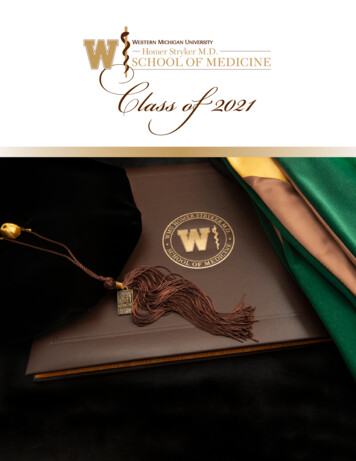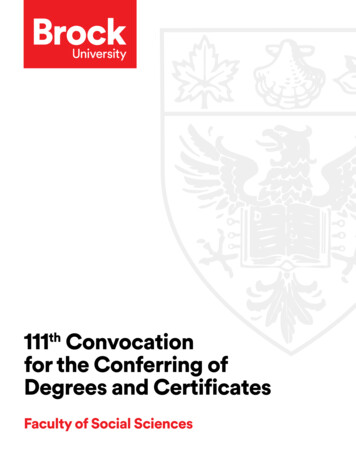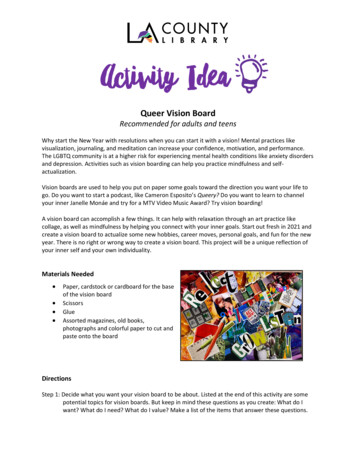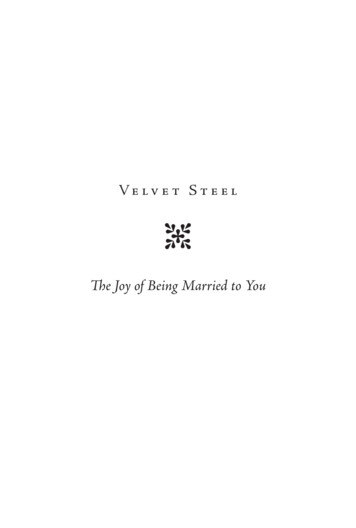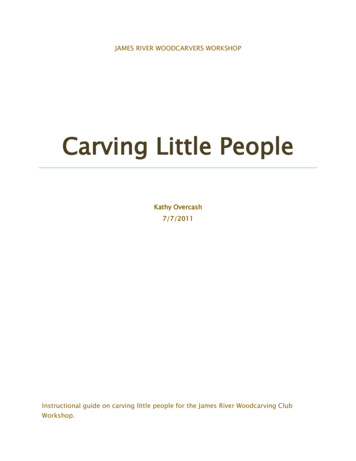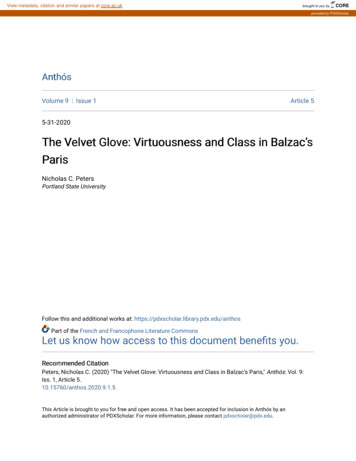
Transcription
View metadata, citation and similar papers at core.ac.ukbrought to you byCOREprovided by PDXScholarAnthósVolume 9Issue 1Article 55-31-2020The Velvet Glove: Virtuousness and Class in Balzac’sParisNicholas C. PetersPortland State UniversityFollow this and additional works at: https://pdxscholar.library.pdx.edu/anthosPart of the French and Francophone Literature CommonsLet us know how access to this document benefits you.Recommended CitationPeters, Nicholas C. (2020) "The Velvet Glove: Virtuousness and Class in Balzac’s Paris," Anthós: Vol. 9:Iss. 1, Article 5.10.15760/anthos.2020.9.1.5This Article is brought to you for free and open access. It has been accepted for inclusion in Anthós by anauthorized administrator of PDXScholar. For more information, please contact pdxscholar@pdx.edu.
The Velvet Glove: Virtuousness and Class in Balzac’s ParisNicholas C. PetersHonoré de Balzac’s novel Père Goriot , tells the story of a tragic fatherwho’s blind love for his daughters drives him to ruin, as well as that of a youngaristocrat who comes to Paris with dreams of conquering high society and takinghis rightful place within aristocracy. As the characters in the story movethroughout the city, Balzac renders a panoramic description of life inmid-nineteenth century Paris. This essay will examine how Balzac’s use of spacein the novel allows him to create a portrait of Paris as he saw it. Close inspectionof the salon scene on pages 52 & 53 between Eugène and the residents of theHotel Restaud (see appendix), and the identification and explication of keytaxonomic elements in this passage paired with secondary scholarship will exhibitBalzac’s critiques of values held by the aristocracy as well as the middle class andhow it represents his views on the change occurring in Paris during this timeperiod of urban modernity. After building a descriptive taxonomy within ansignificant passage in the novel, textual explication will be used to show relationsbetween taxonomy and evidence based analysis that examines how these elementslead to an understanding of Balzac’s views on what constitutes virtue and class in19th century Parisian society.This scene takes place during Eugène’s first visit to the Chaussée d’Antinat the home of Anastasie, a vapid Comtesse from humble origins. After meeting ata ball, Eugène de Rastignac, a young man from the Provinces hoping to make aname for himself in Paris, has set his sight on the Comtesse de Restaud as hismeans of ascension.The interaction between Eugène, the Comtesse, her husband the Comte deRestaud and her lover Maxime, is rich with textual elements that can be used toestablish a robust taxonomy. The paramount device found in this passage is thenarrator’s description and use of imagery. The physical description of the31
characters appearances demonstrates how the characters perceive one another,and what traits they take into account when forming opinions. Language anddiction also play a vital role in understanding the significance of the passage. Thewords used to describe the characters and their actions hold specific connotationsthat reveal deeper meanings within the description and dialogue present in thescene. There is also the indirect historical allusion to the Chaussée d’Antin,which must be considered when curating any aspect of the passage in order toform a historico-contextually accurate understanding of the text.The passage begins when Eugène first sees Maxime. As the narratordescribes him, Maxime’s appearance creates a stark contrast between the twoyoung men. His “handsome, fair, well curled hair” emphasizes the messiness ofEugène’s, and his boots, “elegant and clean” draw his attention to the mud on hisown (Balzac, 52). The description of Maxime is purely physical, and the aspectsremarked upon by the narrator are those which are artificial. Eugène does notcomment on his physique, or his looks, but on the clothes he wears, and thestyling of his hair. Standards of beauty are not based on natural endowments, buton those which can be bought.Maxime brings out a hatred in Eugène, as he perceives him to beflaunting the trappings of everything he hopes to become. Maxime has wealth,he has Anastasie, and he has a place in the aristocracy. The narrator states thatMaxime “felt the superiority which his fine clothes gave,” but what is truly feltis Eugène’s sense of inferiority in the presence of such ostentation (Balzac, 52).He does not feel less than until he sees Maxime, who appears as more than.From his appearance Maxime is attributed with intelligence, elegance, andsuperiority without speaking a word. He embodies all the values of theChaussée d’Antin through the fit of his waist coat and the curl of his hair. Theidea that he so perfectly belongs there emphasizes the fact that Eugène does not.Balzac’s use of physical description and imagery in order to indicatesupposed ethereal qualities reveals what traits and characteristics were used to32
define a person’s character in Parisian high society. In Balzac’s Heaven and Hell ,Michel Philip alludes to Balzac’s description of Paris as “a pretty woman” whendescribing the vanity and values of the city (Philip, 78). This same phrase is usedto describe Maxime, whose “frock-coat most elegantly fitted around the waist,which made him look like a pretty woman” (Balzac, 52). This descriptor used byBalzac to describe both the city and the man further proves Maxime’s right tosuperiority over Eugène. Maxime not only belongs in Paris, he is Paris, andEugène is only a boy from the provinces with no carriage, and dusty boots.Diction and dialogue are also used to uncover deeper meanings within thepassage. The narrator describes the scene using precise language with words thatcarry connotations of battle, rage and violence. The use of diction in this passagereveals hostile undertones within the interactions and dialogue between charactersthat opposes an otherwise dull scene of aristocrats exchanging pleasantries in aparlor. The act of violence is repeatedly alluded to as the narrator describes theseemingly innocuous actions of the characters. Eugène feels a “violent hatred” forMaxime at first sight, as his appearance and ability to suit the lifestyle of theChaussée d’Antin puts Eugène “in a fury” (Balzac, 52). As the narrator describesMaxime’s ability to induce men into a duel to kill them, he rakes the fire with an“angry violence” (Balzac, 52). This description of masculine brutality is sensedby Anastasie, who is “fluttering up and down like a butterfly,” reading thetension between the two men clouds her “lovely face” with distress (Balzac, 53).The battle continues as the three “confronted each other” in front of the fireplace,this language creates almost a second nonverbal dialogue between the characters,that does not align with the spoken.This subtext illuminated by Balzac’s use of diction reveals the malice andantagonism that lurks beneath the opulent and polite façade of the aristocracy.This idea is remarked upon later in the novel when Eugène describes the innerworkings of high society as “the iron hand beneath the velvet glove — thepersonality, the egoism beneath the manner, the wood beneath the varnish”33
(Balzac, 108). This unspoken rancor is affirmed by the narrator when Anastasielooks at him “in such a way that well-bred people would at once start composingthose phrases known as exit lines” (Balzac, 53). Here, the narrator remarks onEugène’s inability to understand the social cues of the upper class, separating himfurther from the aristocracy.This antagonism between the two men grows when the Comte de Restaudenters. He casts a “worried glance” at Eugène, but greets Maxime with a“friendly expression” (Balzac, 53). The words describing the Comte’s attitudetowards them further accentuates the difference in belonging between Maximeand Eugène. He is surprised by the Comte’s manner towards Maxime because heis having an affair with his wife. The narrator attributes this surprise to his ruralupbringing, stating that a boy from the provinces could not understand the“pleasures” of a love triangle.A shift in diction and tone appears when the Comtesse finally introducesEugène, emphasizing his relation to his cousin, the Comtesse de Beausánt. Theintroduction is given by the Comtesse with “pride” in the fact that she has a“person of distinction” in her house. This language indicates that Eugène isdistinguished by his name alone, his birth is his greatest achievement in life. Thisrevelation prompts a swift change in the behavior of Maxime and the Comte. Thisis seen through the description of their actions, as they both drop their “coldlyformal,” and “arrogant manners” (Balzac, 53).The words used to describe the effect of his name exhibit the weight thata title bears in the Hotel Restaud, the Chaussée d’Antin, and all of Paris. Theintroduction of his name is comparable to divine intervention, described as the“wave of a magic wand” as everyone in the room is “affected by the potentmention of a name,” though uneasy, even Maxime must succumb to the“magical effect” of his heritage (Balzac, 53). Eugène is also changed by thisintroduction. He is restored by this “flash of light” which gives him “clearinsight” into the “murky atmosphere of Parisian high society,” and returns the34
wit he lost when he first entered the home. His name has given him clarity andpurpose, it is the only tool he needs to navigate the tempestuous waters of thearistocracy.Creating this taxonomy reveals certain patterns in the text that createpossibilities of meaning. The patterns found in the description of characters inrelation to their worth, as well as diction used to reveal characters’ perceptionsand feelings lead to themes of virtue, ambition, and intelligence of the upper classin nineteenth century Paris. The idea of superiority and intelligence is firstaddressed during the description of Maxime. He perceives Maxime as the ideal,his ultimate goal. His hatred and jealousy spring from the fact that Eugène is notyet there. Maxime is attributed with beauty, intelligence, and superiority basedsolely on his appearance. The basis of comparison is based solely on Maxime’sclothes, hair, carriage, and his relationship to Anastasie. Without speaking a word,he communicates to Eugène that his presence is unwelcome, and unwarranted.Eugène did not feel inferior before visiting the Chaussée d’Antin, butwhen he enters the neighborhood, he finds himself lacking in qualities he oncebelieved himself to possess. He did not change when he crossed the thresholdof the Hotel Restaud, Paris did. Philip states that the city is a “‘moral milieu’.Each neighborhood is a living being characterized by its peculiar traits as wellas by its history and especially its mores” (Philip, 78). The Chaussée d’Antin isthe domain of the “nouveau riche,” where wealth is virtue and noble blood ismore valuable than gold. In a place where intelligence is found in thecleanliness of one’s boots, Eugène is sure to be stupid.It is not until he is made known as an aristocrat by birth that he gains anyrespect, or even acknowledgement from the residents of the Chaussée d’Antin.Eugène is enlightened by the power of his name, and now sees what isconsidered virtuous in the realm of the aristocracy. He regains his wit and“intelligence,” and is confident in his ability to exist in high society. This is hisfirst lesson on navigating Paris, that to move through society is “not to simply35
change social position, but also habits and morality; it is more than an alteration,it is a metamorphosis” (Philip, 79). This metamorphosis occurs when he hearshis name and witnesses its sway over the aristocracy.So, what is the purpose of explicating the morals of the aristocracy? Bypainting a portrait of the upper class and its values with descriptions of itsmembers and their perceptions, Balzac unveils his critique of Parisian highsociety. Eugène’s character acts as a lens through which to observe thearistocracy during Balzac’s time. His struggle to understand how to behave andbe accepted in the Chaussée d’Antin reveals what its residents base their valuesupon. Wealth is equated with virtuousness, but no amount of money can makeone an aristocrat by blood. Therefore, to pervert the true nature of the aristocracyis immoral, and the opulence of the nouveau riche is false virtue.Through this scene Balzac illustrates a Paris in which wealth andself-interest are the foundations of virtue. Eugène’s greed and determination todominate this world seen through the violent diction used to describe hisperception of Maxime is also critiqued by Balzac. He is a classic Balzacian hero,a young man who comes from the provinces to take Paris by storm. His goals arenot deplorable, but his willingness to succumb to the warped morals of thearistocracy in order to achieve them is his tragic flaw. This is an allusion toBalzac’s critique of middle-class ambition due to the post-revolutionary ideal ofsocial mobility, or the ability to change your status through entrepreneurship ormarriage. Although Eugène is an aristocrat by blood, his upbringing in theprovinces and his lack of wealth draws him as a symbol of the middle class inpost-revolutionary Paris. The fact that he is able to move from the country to thecity and worm his way into the upper class while lacking the virtue and status ofan aristocrat is representative of the current state of Parisian society. This passageilluminates Balzac’s views on the cultural change occurring in Paris. He believesthe aristocracy is being perverted by the ambition of the middle class. Thepre-revolutionary days of an impermeable upper class based on birthright has36
gone, and now class can be bought or married. The result of this corruption is thevapid ostentation of the residents of the Chaussée d’Antin. The nouveau richeembody the immoral ideals and the idleness of the characters in this passage.Balzac creates this scene as a condemnation of the current state of the aristocracy,as well as the greed and ambition of the middle class which further corrupts thevalues and integrity of the ruling class.This piece has selected a key passage in Père Goriot and identifiedtextual elements in order to create a taxonomy which reveals patterns fromwhich Balzac’s meaning stem. This essay used textual explication to analyze thedescriptions, and diction used in the chosen passage to explicate a largermeaning in the novel. The contextualization of the text to the Paris in whichBalzac lived, and the construction of an evidentiary archive from both theprimary and secondary texts, offers a new understanding of the text and how itrelates to Balzac’s critique of aristocratic virtues in Parisian high society duringthe nineteenth century.37
ReferencesBalzac, Honoré de, and A. J. Krailsheimer. Père Goriot. Oxford University Press,2009. Accessed March 2020.Philip, Michel. Balzac’s Heaven and Hell. Yale French Studies, No. 32, Paris inLiterature (1964), pp. 77-81. https://doi.org/10.2307/2929432. AccessedMarch 2020.Appendix“Rastignac felt a wave of violent hatred for this young man. In the first placeMaxime’s handsome, fair, well-curled hair showed him how messy his own was.Then Maxime’s boots were elegant and clean, while his own, despite all the carehe had taken on his walk, bore a light coating of mud. Finally Maxime wore afrock-coat most elegantly fitted around the wait, which made him look like apretty woman, while at half-past two in the afternoon Eugène was wearing a blackevening coat. The intelligent son of Charente felt the superiority which fineclothes gave to this tall, slim, clear-eyed, fair-skinned dandy, one of those menwho are quite capable of bringing about an orphan’s ruin. Without waiting forEugène’s reply, Madame de Restaud steed off into the other room, the skirts ofher gown flittering up and down so that she looked like a butterfly. Maximefollowed her. In a fury Eugène followed Maxime and the comtesse. These threethen confronted each other by the fireplace in the centre of the great drawingroom. The student was well aware that he was going to be a nuisance to theodious Maxime, but at the risk of displeasing Madame de rested he wanted to be anuisance to the dandy. Suddenly, remembering that he had seen the young man atMadame de Beauséant’s ball, he guessed that Maxime’s relationship to Madamede Restaud, and with that boldness which can lead the young into the silliesterrors ors the greatest success, he said to himself: ‘That’s my rival, I will defeathim.’ Unwise as he was, he did not know that Comte Maxime de Trailles liked toprovoke insults, fire first and kill his man. Eugène was a good shot, but he had notyet knocked down went dolls out of twenty-two in a shooting gallery. The youngcomte flung himself into an easy chair by the fireside, tool the tongs and raked thefire with such angry violence that Anastasie’s lovely face suddenly clouded withdistress. The young woman turned to Eugène, and looked at him coldly as if toask: ‘But why don’t you leave?’ In which a way that well-bred people would atonce start composing those phrases known as exit lines.Eugène put on his most agreeable look and said, ‘Madame I was in a hurry to seeyou to . . .He stopped short. A door opened. The gentleman who had been driving thetilbury suddenly appeared, bare-headed, did not greet the comtesse, cast a worriedglance at Eugène, and held out his hand to Maxime, saying ‘Good day’ with afriendly expression which peculiarly surprised Eugène. Young men from theprovinces know nothing of the pleasures of a triangular relationship.38
‘Monsieur de Restaud,’ the comtesse said to the student, indicating herhusband.Eugène bowed low.‘Monsieur,’ she went on, introducing Eugène to the Comte de Restaud, ‘isMonsieur de Rastignac, and is related to Madame la Vicomtesse de Beauséantthrough the Marcillacs. I had the pleasure of meeting him at her last ball.’‘Related to Madame la Vicomtesse de Beauséant through the Marcillacs!’These words which the comtesse had stressed almost unduly, prompted by thesort of pride with which a hostess proves that only persons of distinction are to befound in her house, produced magical effect. The comte dropped his coldlyformal manner and bowed to the student.‘Delighted, Monsieur, to make your acquaintance.’Comte Maxime de Trailles himself glanced uneasily at Beauséant andsuddenly dropped his arrogant manner. This wave of a magic wand, affected bythe potent mention of a name, opened up all the closed compartments of ourSoutherner’s brain and restored the ready with which he had earlier prepared. Aflash of light suddenly gave hime clear insight into what had so far been for himthe murky atmosphere of Parisian high society. The Maison Vauquer and PèreGoriot were at that moment far from his thoughts.”39
carry connotations of battle, rage and violence. The use of diction in this passage . workings of high society as "the iron hand beneath the velvet glove — the personality, the egoism beneath the manner, the wood beneath the varnish" 33 (Balzac, 108). This unspoken rancor is affirmed by the narrator when Anastasie




